Algae-covered Indian stone is dangerous when wet because the algae create a slippery surface, significantly increasing the risk of slips and falls. Indian stone, commonly used for paving and landscaping, has a naturally smooth texture. When algae grow on it, the combination of the smooth stone and the slimy algae makes the surface extremely slick, especially when wet. This can be hazardous in areas where people walk, leading to accidents and injuries.
Additionally, the algae can retain moisture, making the stone slippery even after the rain has stopped or in humid conditions. Regular cleaning and maintenance are necessary to prevent algae buildup and ensure the safety of the stone surface.
Steam cleaning is more effective than cold pressure washing for Indian stone for several reasons:
Higher Temperature
Steam cleaning uses high-temperature water (often above 100°C), which effectively breaks down and dissolves dirt, grime, and algae. The heat helps to kill algae, mold, and other microorganisms at their roots, preventing regrowth. Cold pressure washing, on the other hand, may remove surface debris, but it doesn’t kill algae and mold as effectively, allowing them to grow back quickly.
Steam cleaning uses high-temperature water (often above 100°C), which effectively breaks down and dissolves dirt, grime, and algae. The heat helps to kill algae, mold, and other microorganisms at their roots, preventing regrowth. Cold pressure washing, on the other hand, may remove surface debris, but it doesn’t kill algae and mold as effectively, allowing them to grow back quickly.
Deep Cleaning
The heat from steam penetrates the pores of the stone, loosening embedded dirt and contaminants that cold water pressure washing might not reach. This results in a more thorough and long-lasting clean.
The heat from steam penetrates the pores of the stone, loosening embedded dirt and contaminants that cold water pressure washing might not reach. This results in a more thorough and long-lasting clean.
Less Water Usage
Steam cleaning often uses less water than cold pressure washing because the steam’s effectiveness means you don’t need as much water to achieve the same level of cleanliness. This is both environmentally friendly and beneficial in areas with water usage restrictions.
Steam cleaning often uses less water than cold pressure washing because the steam’s effectiveness means you don’t need as much water to achieve the same level of cleanliness. This is both environmentally friendly and beneficial in areas with water usage restrictions.
Gentle on Stone
Steam cleaning is generally less abrasive than cold pressure washing. High-pressure cold water can sometimes cause damage to the surface of the stone, especially if the pressure is too high or the stone has weak spots. Steam cleaning, with its lower pressure and higher temperature, cleans effectively without risking damage to the stone.
Steam cleaning is generally less abrasive than cold pressure washing. High-pressure cold water can sometimes cause damage to the surface of the stone, especially if the pressure is too high or the stone has weak spots. Steam cleaning, with its lower pressure and higher temperature, cleans effectively without risking damage to the stone.
Sanitisation
The high temperature of steam not only cleans but also sanitises the surface, killing bacteria, viruses, and other pathogens that might be present on the stone. Cold pressure washing doesn’t have the same sanitizing effect.
The high temperature of steam not only cleans but also sanitises the surface, killing bacteria, viruses, and other pathogens that might be present on the stone. Cold pressure washing doesn’t have the same sanitizing effect.
Overall, steam cleaning provides a deeper, safer, and more effective cleaning method for Indian stone, particularly when dealing with issues like algae growth.









